About
The Gwich’in Social & Cultural Institute of Alaska (GSCIA) is a non-profit organization founded in 2019 by Gwich’in community members who have dedicated themselves to the revitalization of Dinjii Zhuh K’yàa, the Gwich’in language. We have a particular focus in the field of education and advocate for the reawakening of Dinjii Zhuh K’yàa in our communities. We create language learning products, such as dictionaries, apps, and books.

Mission
We aim to preserve and restore Dinjii Zhuh K’yàa by creating language-learning resources and programs. We believe that by revitalizing our ancestral language, we will strengthen our connection to one another, our Gwich’in culture and worldview. We are a part of the Gwich’in community in Alaska—as represented by the ten Gwich’in villages in the Yukon Flats region—and collaborate with as many facets of our community as possible to achieve our mission.
Alaskan Gwich’in Territory
Gwich’in Nation territory in Alaska is found in the Yukon Flats region, which is an extensive area comprised of wetlands, forests, and mountains surrounding the Yukon, Porcupine, Teedriinjik, K’àii’eechų’njik, and K’iidòotinjik Rivers in the interior of Alaska. There are eight Gwich’in villages in Alaska, including Arctic Village, Beaver, Birch Creek, Canyon Village, Chalkyitsik, Circle, Fort Yukon, and Venetie. Many Gwich’in community members also live in Alaska’s urban areas, such as Fairbanks, which is south of the Yukon Flats region. In order to access Gwich’in villages, one must either fly in or travel by boat.
Dinjii Zhuh K’yàa
Dinjii Zhuh K’yàa is a Dene (Athabascan) language spoken by the Gwich’in people. It is a severely endangered language spoken in northeastern interior Alaska in the Yukon Flats region and northwestern Canada. Speakers in Canada have different dialects than those in the Yukon Flats region of Alaska; however, even Alaskan Dinjii Zhuh K’yàa can be categorized into two mutually-intelligible dialects that are loosely organized by geographic area: (1) Neets’ąįį Gwich’in spoken in and around Arctic Village and Venetie; and (2) Gwichyaa Gwich’in spoken in and around Fort Yukon.
